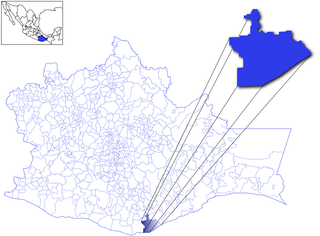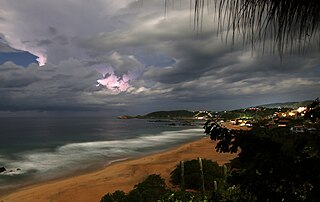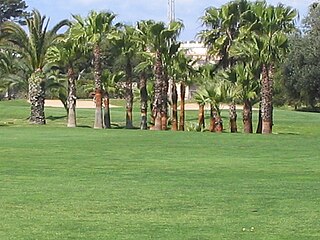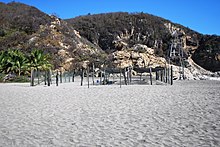
Puerto Escondido is a small port and tourist center in the municipality of San Pedro Mixtepec Distrito 22 in the Mexican state of Oaxaca. Prior to the 1930s, there was no town. The bay had been used as a port intermittently to ship coffee, but there was no permanent settlement due to the lack of potable water. The name "Puerto Escondido" had roots in the legend of a woman who escaped her captors and hid here. The Nahuatl word for this area was Zicatela, meaning “place of large thorns". Today, it refers to the area's most famous beach.

Zihuatanejo, or Ixtapa-Zihuatanejo, is the fourth-largest city in the Mexican state of Guerrero. It was known by 18th century English mariners as Chequetan or Seguataneo. Politically the city belongs to the municipality of Zihuatanejo de Azueta in the western part of Guerrero, but both are commonly referred to as Zihuatanejo. It is on the Pacific Coast, about 240 km northwest of Acapulco and 411 km further south in latitude than Honolulu, Hawaii. Zihuatanejo belongs to a section of the Mexican Pacific Coast known as the Costa Grande. This town has been developed as a tourist attraction along with the modern tourist resort of Ixtapa, 5 km (3.1 mi) away. However, Zihuatanejo has kept its traditional town feel. The town is located on a well-protected bay which is popular with private boat owners during the winter months.

Huatulco, formally Bahías de Huatulco, centered on the town of La Crucecita, is a tourist development in Mexico. It is located on the Pacific coast in the state of Oaxaca. Huatulco's tourism industry is centered on its nine bays, thus the name Bahias de Huatulco, but has since been unofficially shortened to simply Huatulco. Huatulco has a wide variety of accommodation from rooms for rent, small economy hotels, luxury villas, vacation condominia, bed and breakfasts, as well as several luxury resorts standing on or near the shores of Tangolunda Bay. The Camino Real Zaashila, Quinta Real Huatulco, Las Brisas, Dreams Resort & Spa, and the Barceló are examples of the most popular larger resorts in the area.

Mazunte is a small beach town on the Pacific coast of Oaxaca, Mexico. It is located 22 km southwest of San Pedro Pochutla on coastal Highway 200. Mazunte is located some 10 km to the west of Puerto Ángel and just about 1 km from San Agustinillo and 264 km south of the capital of Oaxaca. There are two etymologies for the name. Some sources state that “Mazunte” is derived from a Nahuatl phrase, “maxotetia” which means “please deposit eggs here.” However, older residents of the community state that it is from the word “mizontle,” used by locals to refer to a crab species that used to be very abundant in the area.
Playa Zipolite is a beach community located in San Pedro Pochutla municipality on the southern coast of Oaxaca state in Mexico between Huatulco and Puerto Escondido.

San Pedro Pochutla is a city and municipality located in the south of Oaxaca state, Mexico next to the Pacific Ocean. It is an important commercial, transportation and administrative hub for the Pochutla District in the east of the Costa Region. Pochutla is located at the junction of coastal Highway 200 and Highway 175 to Oaxaca, with 175 functioning as the town's main thoroughfare. Its name means "place of kapok trees ", and most of the city is built on a lakebed which was drained during the colonial period. The municipality is best known as being the home of the oceanside communities of Puerto Ángel and Zipolite.

San Agustinillo is a small fishing village and beach in the state of Oaxaca, Mexico. It is located in the municipality of Santa María Tonameca just east of the coastal communities of Mazunte and La Ventanilla. This is where the Sierra Madre del Sur mountains meet the Pacific Ocean.

Santa María del Tule is a town and a municipality in the Mexican state of Oaxaca. It is part of the Centro District in the Valles Centrales region. It is located 11 kilometers (6.8 mi) SE of the city of Oaxaca on Highway 190. The town and municipality are named for the patron saint of the place, the Virgin Mary and “Tule” comes from the Náhuatl word “tulle” or “tullin” which means bulrush.

Puerto Ángel is a small coastal town in the Mexican state of Oaxaca located in the municipality of San Pedro Pochutla. It, along with San Agustinillo and Playa Zipolite are known as the "Riviera Oaxaqueña". It is located 9 km south of city of Pochutla approximately 50 kilometers west of Huatulco and 80 kilometers east of Puerto Escondido. Despite tourism development since the 1960s, the town is still mostly a fishing village, located on a small bay surrounded by rocky hills that lead into the Sierra Madre del Sur. It was founded in the mid-19th century as a port for the region's coffee and lumber industries but since then other means of shipping these products has replaced it.

La Crucecita, along with Tangolunda and Santa Cruz, comprise the resort area known as Huatulco, in the Mexican state of Oaxaca. It is the community closest to the bays but it is only 4 km (2.5 mi) from Federal Highway 200. It has grown along with the development of tourism in the area. The town is within the Santa María Huatulco municipality, which is part of the Pochutla District in the Costa Region of Oaxaca, Mexico.
Santa Catarina Juquila is a town in the State of Oaxaca, Mexico, and is the seat of the municipality also called Santa Catarina Juquila. It is part of the Juquila District in the center of the Costa Region. The name "Juquila" comes from "Xuhquililla", which means "Place of blue milkweed".

La Ventanilla is a small village on a beach and lagoon in the municipality of Santa María Tonameca, Oaxaca, Mexico. It is best known as an ecotourism center based on its natural resources. It is located on the Costa Chica section of Oaxaca, just west of Mazunte. The La Ventanilla area consists of a long, unbroken stretch of undeveloped beach and a lagoon wedged between the Pacific Ocean and the Sierra Madre del Sur. In the 1990s, the area was nothing more than a coconut plantation with three families living there, and did not have electricity until 1999. Today, the area is home to about twenty five Zapotec families who are dedicated to preserving the ecology of both the beach and the lagoon and live in a small village located on the far east end of the beach.

Mermejita is a small beach village in the central part of Oaxaca's coast, west of San Agustinillo and Mazunte and east of Chacahua. Until recently, the area was completely uninhabited, but now it is attracting adventurers who are building Robinson Crusoe-style houses, using local materials. It is known as a nudist beach, and one of only two places in Oaxaca where the rare leatherback turtle nests.

Cazones de Herrera, or Cazones, is a town and municipality located in the north of the Mexican state of Veracruz on the Gulf of Mexico. While it has tourist attractions along its shore, especially in the Barra de Cazones area, the municipality, including the seat, has a high level of socioeconomic marginalization. Most of the municipality's population works in agriculture.

Santa María Atzompa is a town and municipality located in the Mexican state of Oaxaca, about five km from the state capital of Oaxaca. It is part of the Centro District in the Valles Centrales region. The town was founded between the 7th and 9th centuries as a satellite of the ancient Zapotec city of Monte Albán. Since its founding, pottery making has been a major economic activity and the town is currently known for its green-glazed pottery. This pottery used to be shipped all over Mexico and exported to the United States but today most of this pottery is sold locally. Beginning in 2009, there has been excavation at the Atzompa archeological site, leading to the discovery of a 45-meter Mesoamerican ball court, which has been determined to have been on the principal one for Monte Alban. Today, the town is rustic with the smoke of wood-fired pottery kilns ever present. Poverty has been a concern for the town, but innovations such as the use of lead-free glazing and a communal crafts market have been implemented to improve the craft's prospects.

Santa María Huatulco is a town and municipality in Oaxaca in south-western Mexico. It is part of the Pochutla District in the east of the Costa Region. The meaning of Huatulco, or Guatulco Coatulco is, "where they worship the tree", referring to an ancient legend.

The Costa Region or Costa Chica lies on the Pacific coast of the state of Oaxaca, Mexico, south of the more mountainous Sierra Sur inland from the coast. It includes the districts of Jamiltepec, Juquila and Pochutla.

Juquila District is located in the center of the Costa Region of the State of Oaxaca, Mexico, on the Pacific coast. It has an area of 5,055 km2. As of 2005 it had a total population of 134,365 of whom 33,106 spoke an indigenous language. Economic activities include agriculture and tourism. The Santuario (Sanctuary) de Juquila is a major attraction.

Pochutla District is located in the east of the Costa Region of the State of Oaxaca, Mexico. The primary city is San Pedro Pochutla.

Playa de Escobilla Sanctuary is a waterfront sanctuary for sea turtles in the Mexican state of Oaxaca, with an area of about 30 hectares. The sanctuary lies in Santa María Tonameca Municipality, between the towns of Puerto Escondido and Huatulco near the town of Mazunte. In order to protect the turtles, the beach is guarded during nesting season and is off-limits to tourists. However, during this season visitors can join overnight trips to observe the olive ridley turtles heaving themselves on shore to lay their eggs. These trips help support the local economy, and must be arranged in advance through the Centro Mexicano de la Tortuga.




















